Ireland E-commerce Market Size
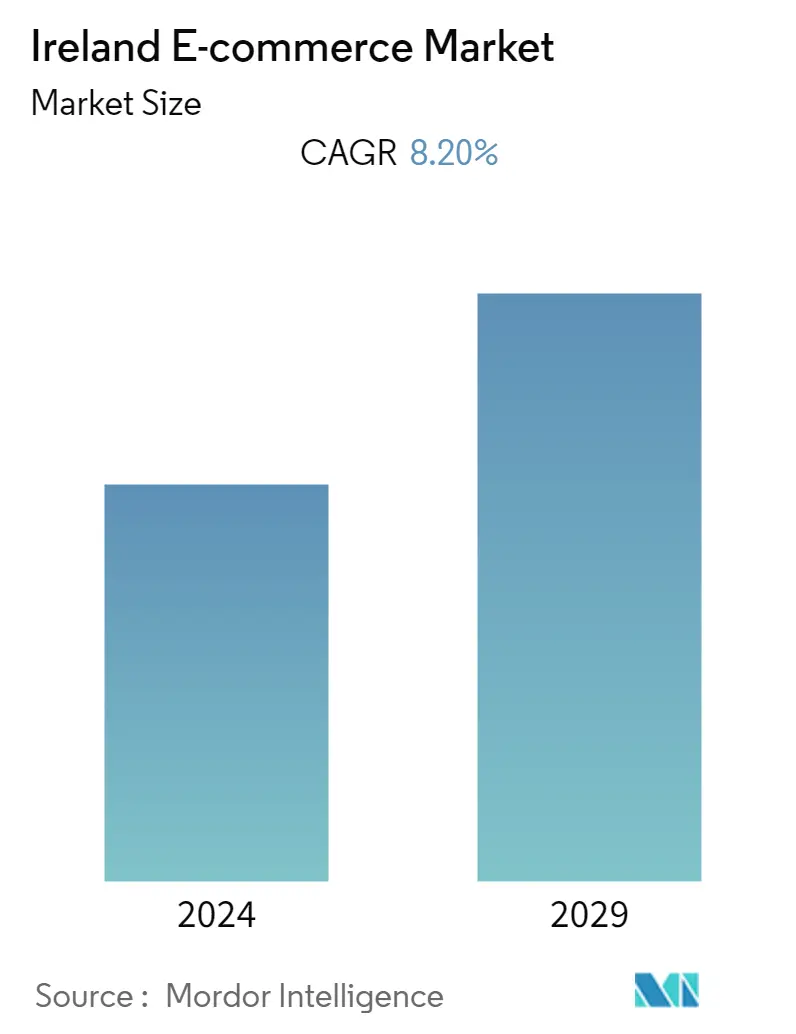
| Study Period | 2019 - 2029 |
| Base Year For Estimation | 2023 |
| Forecast Data Period | 2024 - 2029 |
| Historical Data Period | 2019 - 2022 |
| CAGR | 8.20 % |
| Market Concentration | Low |
Major Players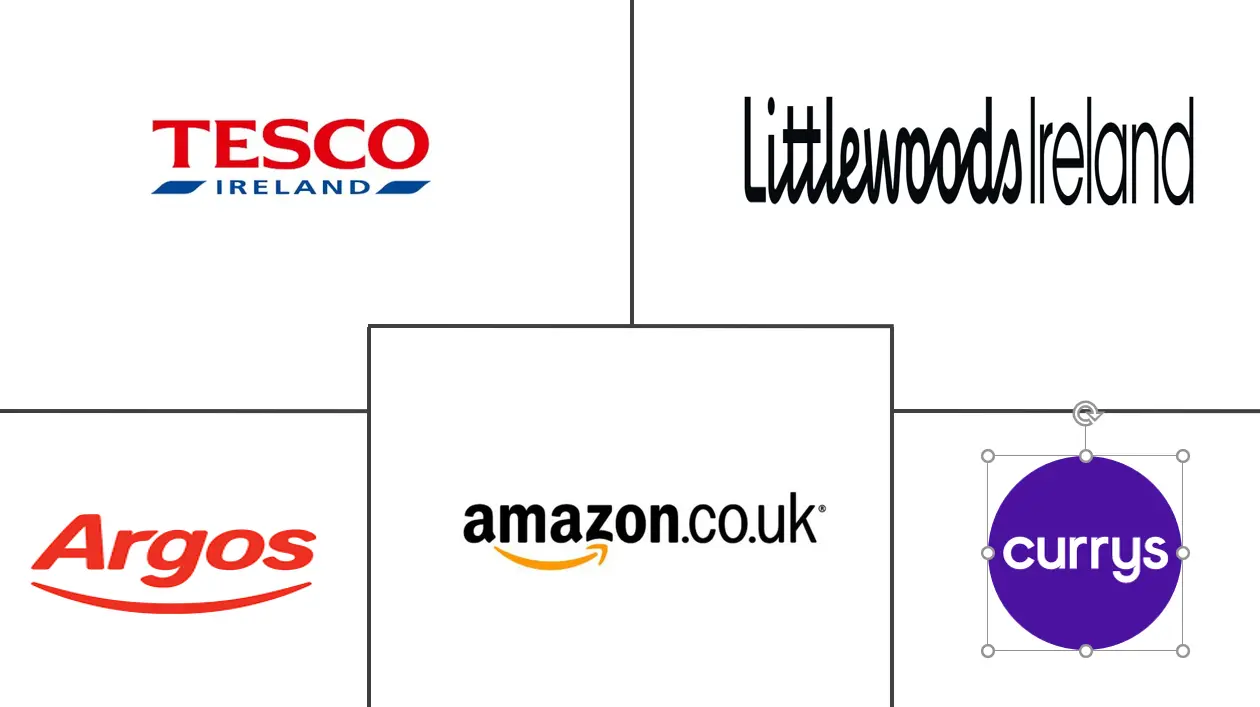
*Disclaimer: Major Players sorted in no particular order |
Ireland E-commerce Market Analysis
The Ireland e-commerce market is expected to register a CAGR of 8.2% from 2022 to 2027. The primary factor driving the growth of the e-commerce market in the region are strong household internet access, high cross-border spending, and rising smartphone usage, among others.
- The key factors influencing the growth of e-commerce in Ireland include the ease, convenience, and security of the payment methods and online retailers investing in making their websites more appealing and user-friendly. The significant growth of alternate payment methods is also boosting the growth of the e-commerce market in the region. Bank transfers and digital wallets are Irish customers' two most used payment methods for online sales. Moreover, increasing smartphone penetration and the arrival of advanced digital wallet solution is further expected to grow the e-commerce market in the region.
- Furthermore, as per Central Statistics Office, Ireland, the proportion of retail sales generated online for All Retail Businesses was 6.5% in December 2021 and 6.0% in November 2021, compared to 5.8% in December 2020. Moreover, in December 2019, the proportion of retail sales transacted online for All Retail Businesses was 4.1%. The share of online generated sales continued to grow at 3.2% in January 2020, 3.5% in February 2020, and 4.5% in March 2020. the share of online sales in November 2020 was 12.4%, 11.0% in January 2021, and 11.8% in February 2021.
- Furthermore, the region's e-commerce market continues to expand faster, with mobile internet retailing becoming especially significant. Retailers in the region are launching dedicated mobile apps while store-based retailers rapidly utilize multi-channel options. Click and collect services have become more widely available, allowing retailers to maximize retail potential without incurring delivery fees. In contrast, the consumer can easily access purchases without planning for deliveries.
- Any security doubt or risk in the minds of consumers while shopping online can negatively affect consumers and their motives to purchase products or services online. Their main concern is the stealing of their credit card information. This factor can negatively impact the e-commerce market in the region.
- The COVID-19 outbreak has rapidly forced numerous entities (public, business, and private) to become predominantly oriented to e-commerce during the pandemic. Moreover, the pandemic accelerated the move to digital for Irish consumers. The pandemic has increased the scope of e-commerce and the range of services in Ireland despite the deteriorating economic and social situation.
Ireland E-commerce Market Trends
This section covers the major market trends shaping the Ireland E-commerce Market according to our research experts:
Rising Adoption of Card Payments and M-commerce
- Market players in the region are optimizing their sites for mobile devices and offer seamless card payments owing to the increase in m-commerce. Consumers in the region are more likely to close a transaction on the go, and card payment is the most popular choice for completing the payment.
- The government's support for card payments drives the region's payment acceptance. The Irish government has implemented a debit card interchange fee cap of 0.1%, a 50% reduction on the standard EU cap of 0.2 percent. The interchange fee cap on credit cards was maintained at the EU level of 0.3%.
- Other payment methods for online shopping, such as bank transfers and cash, are set to shrink in use. Ireland looks set to become a significant e-commerce market driven by rapid growth in card payments, with digital wallets also growing in line with rising m-commerce and smartphone use.
- Mobile commerce is becoming increasingly faster to access and use. 5G mobile access speeds are slowly being rolled out across Ireland, starting in cities and major venues before reaching rural areas. Along with growing smartphone penetration and ease of use, the m-commerce market in the region is expected to grow.
- As per the Central Bank of Ireland, total in-store spending amounted to EUR 3.6 billion in March 2022, 15% higher than February 2022, and represented an increase of 34%, or EUR 905 million, compared to March 2021. Total online expenditure increased by 11% compared to February 2022 to EUR 3.1 billion and 9% compared to March last year. Moreover, Online spending accounted for 47% of overall PoS spending in March, a decrease of 1% compared to February.
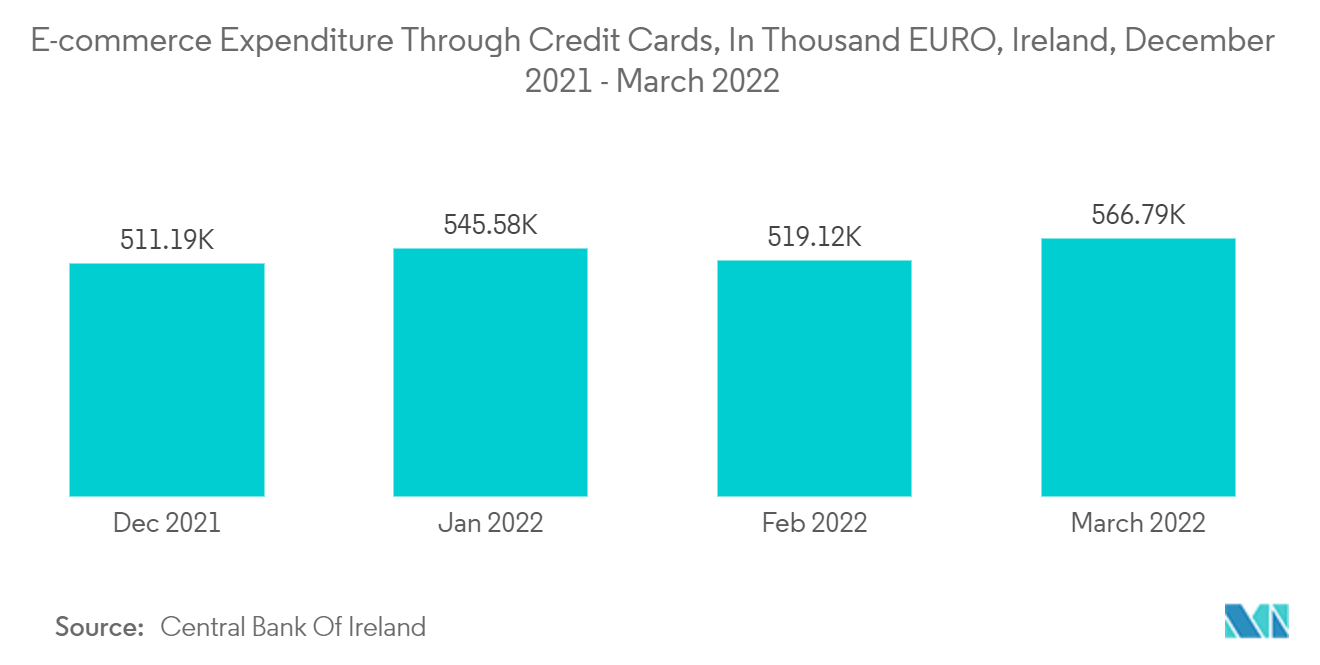
The Fashion and Apparel Segment Accounted for Largest Market Share
- One of the leading trends in the fashion segment is the direct integration of shopping functionality to the content display on social media, enabling high-speed, inspiring, and selling customer conversion. The audience in the region is increasingly shifting from desktop to mobile, and with increasing m-commerce, the trend is expected to grow further over the years.
- According to the Central Statistics Office, Ireland, the turnover percentage generated by online retail sales of clothing, footwear, and textile was 8.1% in September 2021, and it increased to 14.1% in January 2022.
- More consumers flock to e-commerce companies that sell cheap fashionable clothes, referred to as disposable clothes. Despite a drop in discretionary spending, consumers still purchase clothes monthly but opt for disposable items from e-commerce companies, including Dunnes Stores, Tesco Ireland, and discounters.
- Ireland's fashion industry is expanding yearly with the increasing number of fashion bloggers, stylists, and influencers. Social media or social commerce greatly affects sales growth, recognition, brand recognition, and wealth. Moreover, the rising internet and smartphone penetration also boost the e-commerce market in the region.
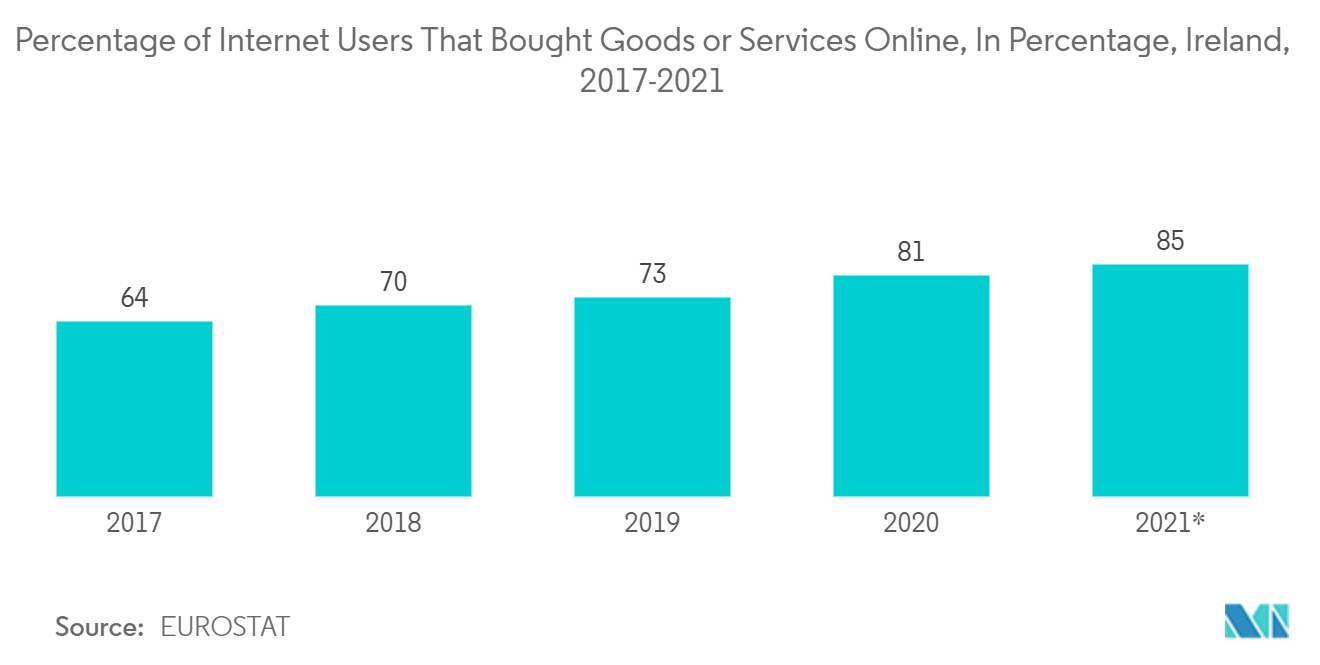
Ireland E-commerce Industry Overview
The Ireland e-commerce market is significantly competitive with several players such as Amazon.co.uk, Tesco Ireland, Argos Ireland Limited, etc. The regional companies are increasing their presence in the market by introducing new payment systems and offerings or entering into strategic partnerships or acquisitions.
- March 2022 - PlantX Life Inc. announced that its wholly-owned subsidiary, Bloomboxclub Limited, has launched its indoor plant selling e-commerce platform in Ireland. For purchases made through the Irish e-commerce platform, orders will be shipped from a distributor in the Netherlands using the same centralized fulfillment and distribution system as other Bloombox Club operations in Europe.
Ireland E-commerce Market Leaders
-
Amazon.co.uk
-
Argos Distributors (Ireland) Limited
-
Tesco Ireland
-
Currys Ireland Limited
-
Littlewood Ireland
*Disclaimer: Major Players sorted in no particular order
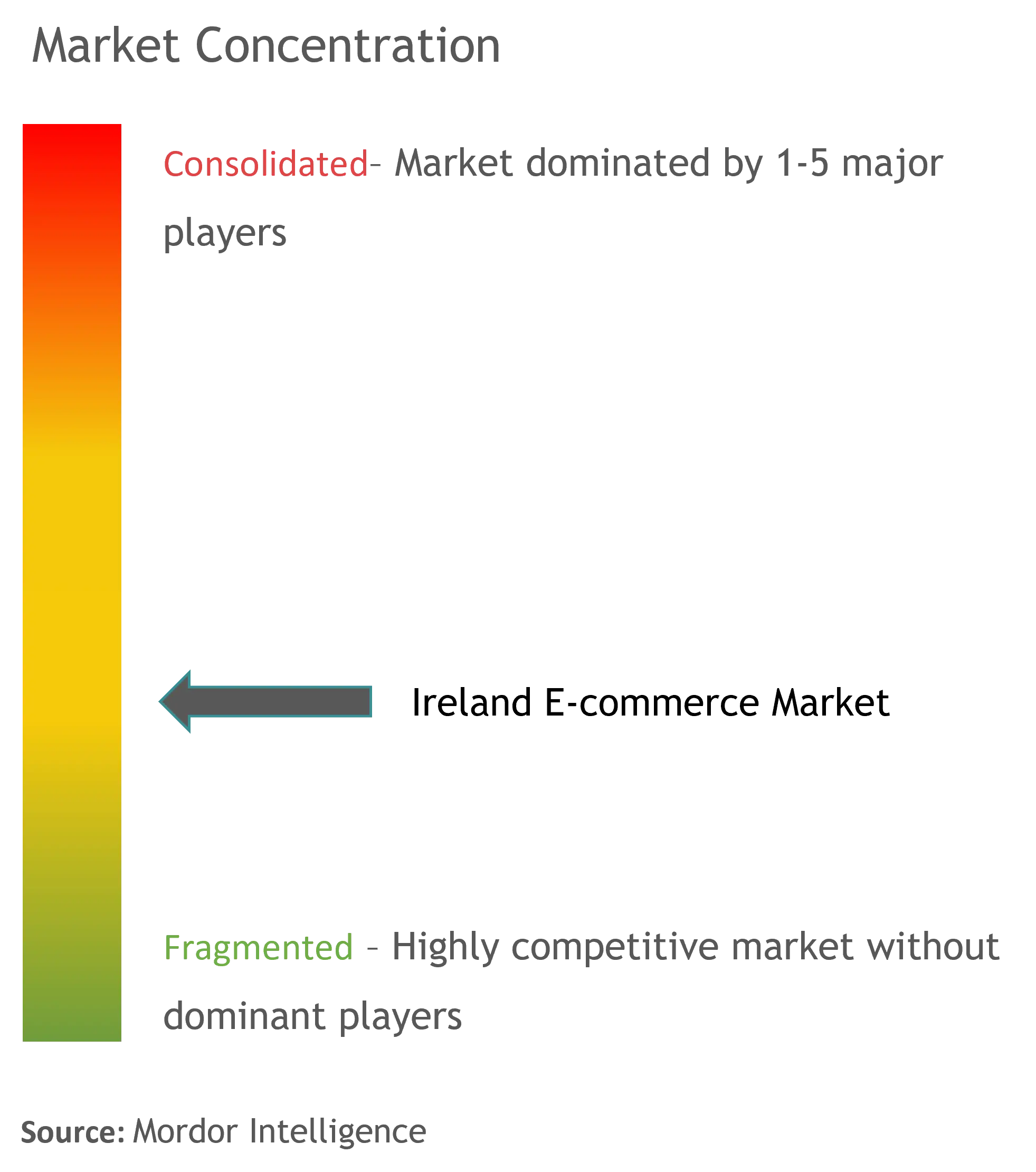
Ireland E-commerce Market News
- March 2022 - Canadian investment firm Clearco announced to invest EUR 100 million in Irish e-commerce start-ups while also establishing an international sales hub in Dublin. Its expansion in Ireland will create an international sales hub in Dublin, with 125 jobs.
- September 2021 - American clothing retailer Gap announced its plans to amplify its European business through a partnership with Next Plc, a British multinational clothing, footwear, and home products retailer, for its business in the UK & Ireland. Gap aims to benefit from Next's extensive Omni platform and e-commerce expertise as the UK's top online clothing retailer.
Ireland E-commerce Market Report - Table of Contents
1. INTRODUCTION
- 1.1 Study Assumptions and Market Defination
- 1.2 Scope of the Study
2. RESEARCH METHODOLOGY
3. EXECUTIVE SUMMARY
4. MARKET INSIGHTS
- 4.1 Market Overview
-
4.2 Industry Attractiveness - Porter's Five Forces Analysis
- 4.2.1 Bargaining Power of Suppliers
- 4.2.2 Bargaining Power of Buyers/Consumers
- 4.2.3 Threat of New Entrants
- 4.2.4 Threat of Substitute Products
- 4.2.5 Intensity of Competitive Rivalry
- 4.3 Key Market Trends and Share of E-commerce of Total Retail Sector
- 4.4 Impact of COVID-19 on the E-commerce Sales
5. MARKET DYNAMICS
-
5.1 Market Drivers
- 5.1.1 Rising Adoption of Card Payments and M-commerce
- 5.1.2 Significant Household Internet Access and High Cross-border Spending
-
5.2 Market Challenges
- 5.2.1 Challenges Related to Brexit and New EU VAT Rules
- 5.3 Analysis of Key Demographic Trends and Patterns Related to E-commerce Industry in Ireland (Coverage to Include Population, Internet Penetration, E-commerce Penetration, Age & Income etc.)
- 5.4 Analysis of the Key Modes of Transaction in the E-commerce Industry in Ireland (Coverage to Include Prevalent Modes of Payment Such as Cash, Card, Bank Transfer, Wallets, etc.)
- 5.5 Analysis of Cross-Border E-commerce Industry in Ireland (Current Market Value of Cross-border & Key Trends)
- 5.6 Current Positioning of Ireland in the E-commerce Industry in Europe
6. MARKET SEGMENTATION
-
6.1 By B2C E-commerce
- 6.1.1 Market Size (GMV) for the Period of 2017-2027
- 6.1.2 Market Segmentation - by Application
- 6.1.2.1 Beauty and Personal Care
- 6.1.2.2 Consumer Electronics
- 6.1.2.3 Fashion and Apparel
- 6.1.2.4 Food and Beverages
- 6.1.2.5 Furniture and Home
- 6.1.2.6 Others (Toys, DIY, Media, etc.)
-
6.2 By B2B E-commerce
- 6.2.1 Market Size for the Period of 2017-2027
7. COMPETITIVE LANDSCAPE
-
7.1 Company Profiles
- 7.1.1 Amazon.co.uk
- 7.1.2 Argos.ie
- 7.1.3 Tesco.ie
- 7.1.4 Currys Ireland Limited
- 7.1.5 Littlewoods Ireland
- 7.1.6 Next.ie
- 7.1.7 Woodies.ie
- 7.1.8 Harveynorman.ie
- 7.1.9 Jdsports.ie
- 7.1.10 Screwfix.ie
- *List Not Exhaustive
8. Investment Analysis
9. Future Outlook of the Market
** Subject To AvailablityIreland E-commerce Industry Segmentation
E-commerce significantly impacts consumer behavior and is beneficial in many ways. Firstly, consumers do not have to step out and can shop from the comfort of their homes using any devices such as a laptop or even their mobile phones. Secondly, consumers can look into different websites to compare and contrast prices and find the cheapest rates available according to their needs.
The Ireland E-commerce Market is Segmented into B2C E-commerce (Beauty and Personal Care, Consumer Electronics, Fashion and Apparel, Food and Beverage, Furniture and Home), and B2B E-commerce.
| By B2C E-commerce | Market Size (GMV) for the Period of 2017-2027 | |
| Market Segmentation - by Application | Beauty and Personal Care | |
| Consumer Electronics | ||
| Fashion and Apparel | ||
| Food and Beverages | ||
| Furniture and Home | ||
| Others (Toys, DIY, Media, etc.) | ||
| By B2B E-commerce | Market Size for the Period of 2017-2027 |
Ireland E-commerce Market Research FAQs
What is the current Ireland E-commerce Market size?
The Ireland E-commerce Market is projected to register a CAGR of 8.20% during the forecast period (2024-2029)
Who are the key players in Ireland E-commerce Market?
Amazon.co.uk, Argos Distributors (Ireland) Limited, Tesco Ireland, Currys Ireland Limited and Littlewood Ireland are the major companies operating in the Ireland E-commerce Market.
What years does this Ireland E-commerce Market cover?
The report covers the Ireland E-commerce Market historical market size for years: 2019, 2020, 2021, 2022 and 2023. The report also forecasts the Ireland E-commerce Market size for years: 2024, 2025, 2026, 2027, 2028 and 2029.
Ireland E-commerce Industry Report
Statistics for the 2024 Ireland E-commerce market share, size and revenue growth rate, created by Mordor Intelligence™ Industry Reports. Ireland E-commerce analysis includes a market forecast outlook 2029 and historical overview. Get a sample of this industry analysis as a free report PDF download.



